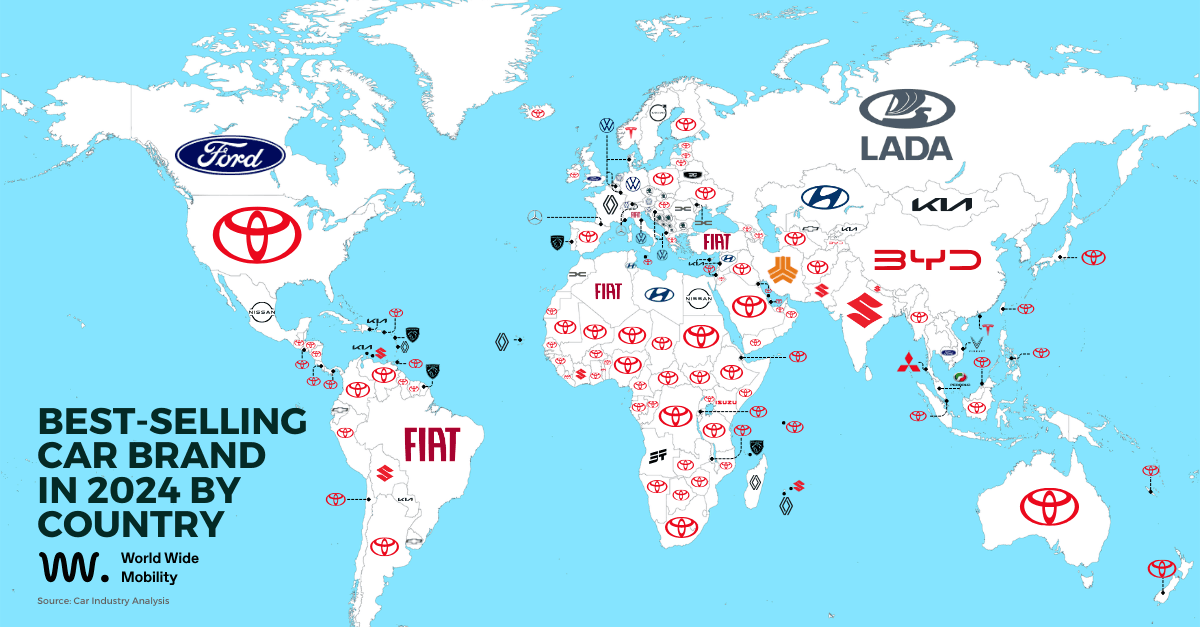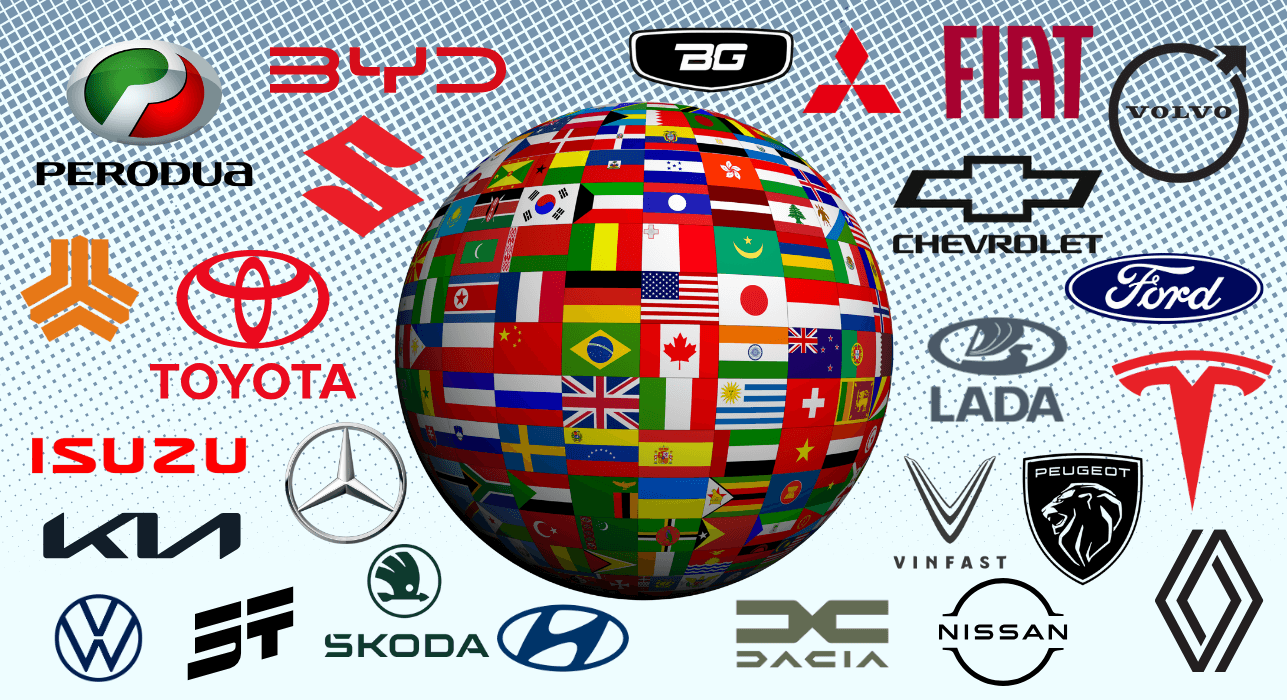What Was the Best-Selling Car Brand in 2024?
In 2024, Toyota once again consolidated its position as the world’s best-selling car brand. However, when looking at individual countries, the picture changes: regional manufacturers, European brands, and fast-growing Chinese automakers also managed to claim the top spot in several markets.
Below you’ll find a visual map and complete list of the most sold car brand by country in 2024, along with an in-depth analysis of global, regional, and future automotive trends heading into 2025.
This article answers one of the most common questions car buyers and enthusiasts ask every year:
- What is the most sold car brand in my country?
- Which car brand sold the most cars in 2024 worldwide?
Here you’ll find clear, accurate, and data-driven answers.

Complete List of Best-Selling Car Brands by Country in 2024 (A–Z)
The following ranking shows the leading car brand in sales for each country in 2024, with notable market share insights included where available.
A
- Albania – Volkswagen – 18%
- Algeria – Fiat – 65%
- Andorra – Mercedes – 10%
- Angola – Jetour – 20%
- Argentina – Toyota – 22%
- Aruba – Kia – 26%
- Australia – Toyota – 19%
- Austria – Volkswagen – 15%
- Azerbaijan – Toyota – 19%
B
- Bahrain – Toyota – 33%
- Belarus – Belgee – 42%
- Belgium – Volkswagen – 10%
- Benin – Toyota – 21%
- Bolivia – Suzuki – 19%
- Bosnia – Skoda – 19%
- Botswana – Toyota – 34%
- Brazil – Fiat – 21%
- Brunei – Toyota – 25%
- Bulgaria – Skoda – 13%
- Burkina Faso – Toyota – 24%
C
- Cambodia – Ford – 25%
- Cameroon – Toyota – 20%
- Canada – Ford – 14%
- Cape Verde – Renault – 24%
- Central African Republic – Toyota – N/D
- Chad – Toyota – N/D
- Chile – Toyota – 8%
- China – BYD – 15%
- Colombia – Toyota – 15%
- Congo – Toyota – 28%
- Costa Rica – Toyota – 22%
- Croatia – Volkswagen – 12%
- Curaçao – Suzuki – 8%
- Cyprus – Kia – 13%
- Czechia – Skoda – 31%
D
- Denmark – Volkswagen – 12%
- Djibouti – Toyota – 55%
- Dominican Rep – Kia – 17%
- DR Congo – Toyota – 25%
E
- Ecuador – Chevrolet – 19%
- Egypt – Nissan – 17%
- El Salvador – Toyota – 22%
- Estonia – Toyota – 19%
- Ethiopia – Toyota – 34%
F
- Finland – Toyota – 16%
- France – Renault – 19%
- Fr. Guiana – Peugeot – 20%
- Fr. Polynesia – Peugeot – 11%
G
- Gabon – Toyota – 17%
- Georgia – Toyota – 33%
- Germany – Volkswagen – 19%
- Ghana – Toyota – 19%
- Greece – Toyota – 18%
- Guadeloupe – Peugeot – 14%
- Guatemala – Toyota – 32%
- Guinea – Toyota – 23%
- Guyana – Toyota – N/D
H
- Honduras – Toyota – 19%
- Hong Kong – Tesla – 22%
- Hungary – Toyota – 12%
I
- Iceland – Toyota – 17%
- India – Suzuki – 37%
- Indonesia – Toyota – 36%
- Iran – Saipa – 32%
- Iraq – Toyota – 35%
- Ireland – Toyota – 13%
- Israel – Toyota – 14%
- Italy – Fiat – 10%
- Ivory Coast – Suzuki – 41%
J
- Japan – Toyota – 31%
- Jordan – Toyota – 32%
K
- Kazakhstan – Hyundai – 22%
- Kenya – Isuzu – 47%
- Korea – Hyundai – 34%
- Kosovo – Skoda – 12%
- Kuwait – Toyota – 28%
- Kyrgyzstan – Kia – 18%
L
- Latvia – Toyota – 18%
- Lebanon – Kia – 15%
- Liberia – Toyota – 44%
- Libya – Hyundai – N/D
- Liechtenstein – Mercedes – 11%
- Lithuania – Toyota – 21%
- Luxembourg – Volkswagen – 13%
M
- Madagascar – Renault – 17%
- Malawi – Toyota – 50%
- Malaysia – Perodua – 45%
- Mali – Toyota – N/D
- Malta – Toyota – 12%
- Martinique – Renault – 17%
- Mauritania – Toyota – N/D
- Mauritius – Suzuki – 21%
- Mayotte – Peugeot – 18%
- Mexico – Nissan – 17%
- Moldova – Dacia – 13%
- Monaco – Mercedes – 18%
- Mongolia – Kia – 15%
- Montenegro – Skoda – 19%
- Morocco – Dacia – 22%
- Mozambique – Toyota – 18%
- Myanmar – Mitsubishi – 12%
N
- Namibia – Toyota – 47%
- Nepal – Suzuki – 31%
- Netherlands – Volkswagen – 10%
- N. Caledonia – Toyota – 21%
- New Zealand – Toyota – 25%
- Nicaragua – Toyota – 44%
- Niger – Toyota – 43%
- Nigeria – Toyota – 77%
- N. Macedonia – Skoda – 14%
- Norway – Tesla – 15%
O
- Oman – Toyota – 52%
P
- Pakistan – Suzuki – 45%
- Panama – Toyota – 21%
- Paraguay – Kia – 16%
- Peru – Toyota – 22%
- Philippines – Toyota – 46%
- Poland – Toyota – 18%
- Portugal – Peugeot – 11%
- Puerto Rico – Toyota – 25%
Q
- Qatar – Toyota – 31%
R
- Reunion – Renault – 21%
- Romania – Dacia – 26%
- Russia – Lada – 20%
- Rwanda – Toyota – 28%
S
- San Marino – Volkswagen – 16%
- Saudi Arabia – Toyota – 28%
- Senegal – Toyota – 34%
- Serbia – Skoda – 20%
- Seychelles – Toyota – 17%
- Singapore – Toyota – 19%
- Slovakia – Skoda – 19%
- Slovenia – Volkswagen – 15%
- Somalia – Toyota – N/D
- South Africa – Toyota – 25%
- South Sudan – Toyota – N/D
- Spain – Toyota – 9%
- Sudan – Toyota – 17%
- Suriname – Toyota – N/D
- Sweden – Volvo – 15%
- Switzerland – Volkswagen – 11%
- Syria – Hyundai – 88%
T
- Taiwan – Toyota – 29%
- Tajikistan – BYD – 41%
- Tanzania – Toyota – 25%
- Thailand – Toyota – 42%
- Togo – Toyota – 19%
- Trinidad & Tobago – Toyota – 17%
- Tunisia – Hyundai – 12%
- Turkiye – Fiat – 11%
- Turkmenistan – Toyota – 62%
U
- UAE – Toyota – 24%
- Uganda – Toyota – 47%
- UK – Ford – 10%
- Ukraine – Toyota – 14%
- Uruguay – Chevrolet – 16%
- USA – Toyota – 13%
- Uzbekistan – Chevrolet – 74%
V
- Venezuela – Toyota – 41%
- Vietnam – Vinfast – 20%
W
- Western Sahara – Toyota – N/D
Y
- Yemen – Toyota – 94%
Z
- Zambia – Toyota – 23%
- Zimbabwe – Toyota – 16%
Key Global Automotive Trends in 2024
- Toyota, the global leader: The brand ranked No. 1 in sales across more than 70 countries.
- Europe’s diversified market: Volkswagen, Renault, Dacia, and Fiat maintained strongholds in their historical markets.
- Asia’s rise: BYD in China and Tajikistan, VinFast in Vietnam, and Hyundai in South Korea, Syria, and Kazakhstan highlight how regional automakers are gaining ground.
- Mixed results in the Americas: Toyota dominated much of Latin America, but Chevrolet and Fiat held leadership in countries like Brazil, Uruguay, and Ecuador.
- Africa remains Toyota territory: Most of the continent favored the Japanese brand, with only a few exceptions.
Outlook for 2025: What Car Brands Will Dominate?
Looking ahead, 2025 is expected to bring more competition from Chinese brands such as BYD and Geely in emerging markets, along with faster growth of electric vehicles in Europe and North America. While Toyota is likely to maintain its global leadership, regional markets are becoming increasingly fragmented, making the race more dynamic than ever.
